Daily Routine
To develop good learning attitude and healthy habit, help your child establish regular daily routine early to instil initiation and self-discipline in her. The daily routine should include:
- Regular meals
- Regular bedtime
- Free time, play and physical activity
- Study time
- Parent-child reading time
- Parent-child playtime
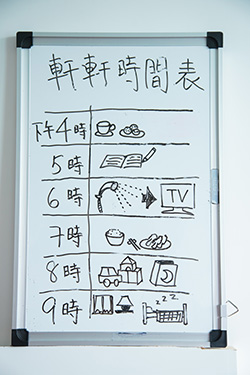
The routine should be arranged according to your child's characteristics. Young children have short attention span and low persistence. Their learning efficiency will be more satisfactory if study and doing homework are broken down into phases. The same applies to physical activity. Children of 3 to 6 years old need about 10 to 13 hours of sleep. Their nap time will get shorter since 4 years old and they may not need any naps when they are 5. You may arrange the daily schedule according to your child's needs, so that he will have a balance in time for learning, parent-child activities, free time to rest and explore, and physical activities.
Eating
Besides providing adequate nutrients, a balanced diet can help your child develop good eating habit. As children grow up, their eating habit may change. Your patience is needed to foster good eating habit and healthy growth in your child.
Tips on Healthy Diet
The age period of 2 to 6 years is a crucial time for your child's growth and development. They use more thinking and language in learning and their eating habits are closer to those of adults. To be a good role model, it is important that you keep to a healthy diet.
How Much Should My Child Eat?
To ensure that your child takes in sufficient nutrients, you need to consider both the “quality” and “quantity” of food in order to have a balanced diet to meet the needs for your child's growth. The “Healthy Eating Food Pyramid” is your good guide! You can choose a variety of food from each food group according to the proportion.
Healthy Eating Food Pyramid for 2 to 5 Years Old
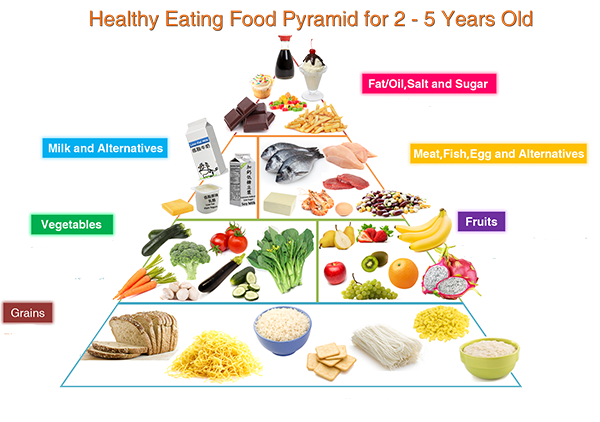
- Grains: eat the most. 1½ – 3 bowls of grains a day e.g.brown rice, wholemeal bread, pasta (1 bowl = 250 to 300ml)
- Vegetables: at least ¾ bowl of cooked vegetables each day
- Fruits: at least 1 medium-sized fruit such as orange or apple a day
- Meat, fish, egg and alternatives: 1½ to 3 taels of meat or fish daily (1 tael = size of a ping-pong ball)
- Milk and alternatives: 2 glasses per day (1 glass = 240 ml)
- Fat or oil, salts and sugar: eat the least
- Drink 4 to 5 glasses of fluid every day including water, milk, clear soup, etc
How Much Should Be Served for Each Meal?
Breakfast, lunch, dinner and snacks provide your child with the energy and nutrition needed. You may refer to the following:
- Breakfast 30%
- Lunch 30%
- Morning and afternoon snacks 10%
- Dinner 30%
Meal Arrangements to Fulfill Daily Calorie and Nutritional Needs
For main meals, you can provide your child with proper amounts of grains, vegetables and meat by following the “321” ratio.
Grains should make up half of a main meal since they are the main source of energy. Dishes comprise of mainly vegetables takes up one-third of a meal, with one-sixth being the fish, meat, eggs, beans and alternatives. Lean meat, fish and skinless poultry are good choices of meat. Choose water, soy milk with low sugar, low fat milk or pure natural fruit juice for drinks.
Keep in mind that food has to be of wide variety and fresh. Do not choose processed or fatty food for your child.
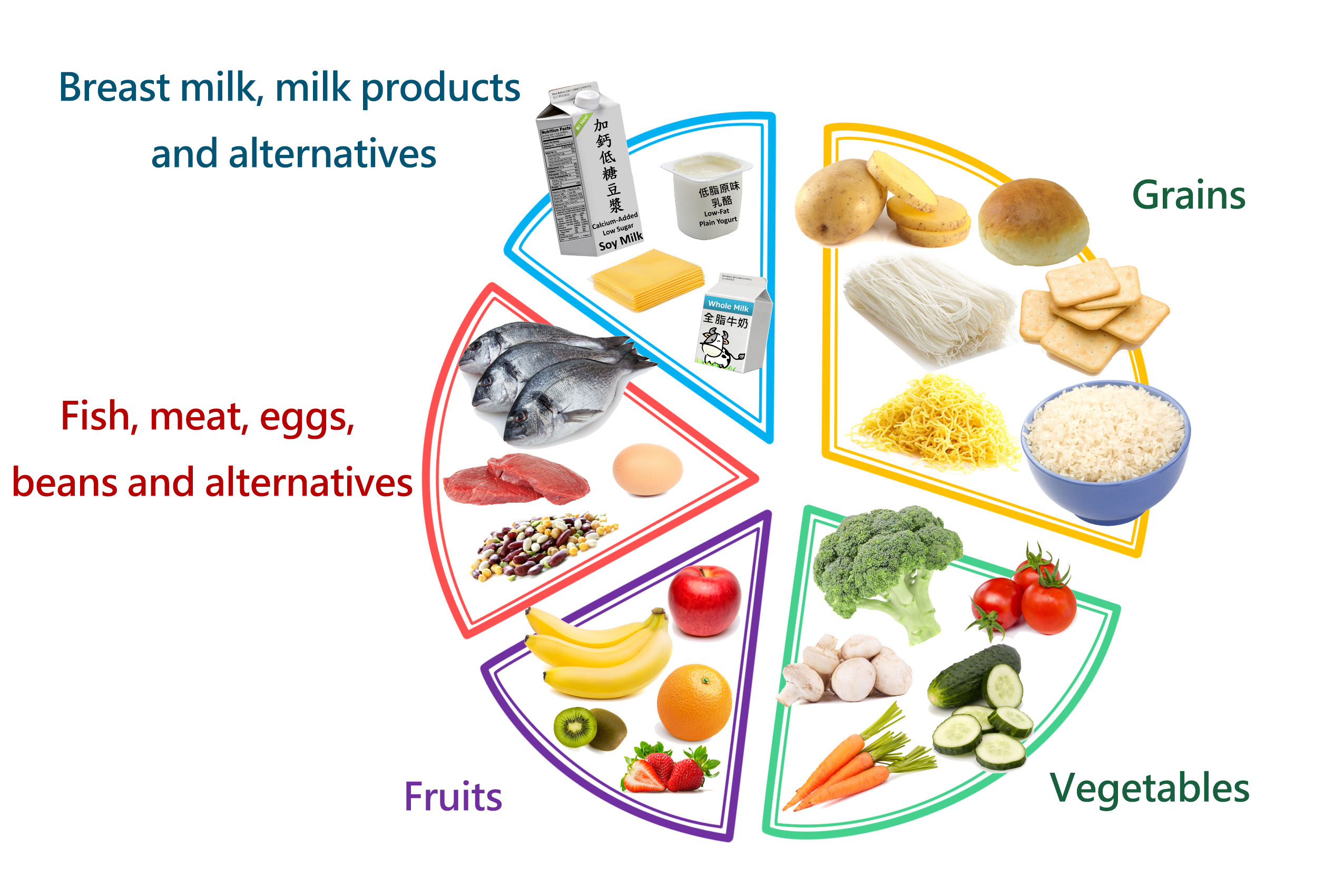
Healthy Snacks
Healthy snacks help to top up water and energy lost during activities and act as a supplementary source of nutrients. However, eating too much or unhealthy snacks would lead to excessive energy intake and result in overweight. It also reduces their appetite for main meals, which leads to insufficient nutrient intake and possible negative impact on health. Bear in mind principles of healthy eating when giving your child snacks, so that he can get the most benefits from healthy snacks.
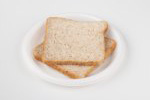




What Can I Do with My Picky Eating Child?
Picky eating is common among little children. However, most of them grow out of the problem when you understand the reasons and help them appropriately. Your child needs your patience and modelling to help them get rid of picky eating.
Eating Out
Many parents often dine out with their children. However, you may fall into the traps of high salt, high fat and high sugar foods easily. The following tips help you to enjoy healthier dishes with your family,
- Following the proportion of “Healthy Eating Food Pyramid” when ordering food. Grains should take up the largest amount, followed by more vegetables and less meat.
- Choose steamed, baked, grilled, poached or stewed dishes. Avoid dishes with sauces high in fat or salt (e.g. white sauce, cream sauce, curry sauce, coconut sauce or teriyaki sauce). You may request the sauce to be served separately.
- Choose wholegrain products or grains and cereals with higher fibre contents (e.g. red rice, brown rice, multi-grain bread, wholemeal bread, oatmeal, etc.). Avoid those high in fat (e.g. E-fu noodles, instant noodles, oily noodles, croissants, etc.)
- Avoid processed food, cured food, fatty cut of meat and poultry with skin (e.g. chicken wings and feet, pork bones, ribs, beef briskets, pork belly and pork jowl)
- For desserts, choose fruit or fruit-based ones.
- Water is the best choice for drinks. Children should avoid soft drinks, sugary drinks, tea, coffee or other drinks containing caffeine.
- When ordering food, make reasonable requests such as “less salt”, “less oil”, “less sugar”, “sauce to be separately served”, “no sauce” and have the syrup separately served for drinks and desserts.
Physical Activities
Children need sufficient physical activities to build up a healthy body. Fun and game-like activities help to increase children's interest in physical activities. Taking his age and unique qualities into consideration, try to meet your child's developmental needs and have fun when doing physical activities with your child.
Arranging Physical Activities for Children
For young children, physical activity includes running, jumping, climbing, throwing, walking, singing and dancing, and playing in the park. The Department of Health recommends that young children aged 3 – 6 should spend at least 180 minutes in a variety of physical activities of different intensity levels, including at least 60 minutes of moderate- to vigorous-intensity physical activity spread throughout the day; more is better.


When children engage in physical activities of moderate to vigorous intensities, their breathing rate and heart rate increases. Examples of moderate to vigorous intensities physical activities are rope skipping, dancing, playing football, playing slide, swinging, and cycling.
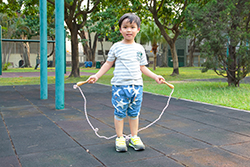
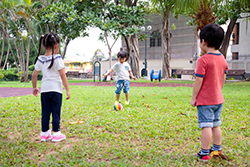
Apart from having physical activities in kindergarten, parents should also provide opportunities for them to engage in physical activities after school. Parents may add game elements to physical activities to enjoy some fun parent-child times together. Climbing stairs, cleaning up toys, and doing simple household chores, etc., are physical activities that may be incorporated into daily lives. This allows your children to achieve the recommended level of physical activity with ease and build a healthy lifestyle from an early age. Besides, let children expose to sunlight during outdoor physical activities help their body produce vitamin D.


Children should not spend more than 1 hour in a day on screen activities such as watching TV or playing screen games, etc. Less sedentary screen time is the better.
Encouraging Your Child to be Active
For children who are not used to do exercise, they may start from everyday physical activity. Give him more opportunities to learn and try. You will build up his sense of achievement and confidence when you encourage and praise him for trying. Remember do not reward his effort by food or screen-time.
Electronic Products
From TV, video games, computers, smart phones to tablets, there is a wide variety of screen-media products nowadays. Many people consider screen-media learning an inevitable trend for children, and the earlier the better. However, “screen time” is mostly sedentary. Studies have shown that screen time is negatively associated with the well-being of children as it:
- Reduces the amount of physical activity children should have and leads to obesity
- Hinders motor and language development of children
- Leads to unhealthy eating habits
- Increases chances of children Imitating problem behaviours
- Affects sleep quality, attention, social and communication skills.


Therefore, you need to cut down screen time together with your child as a role model.
Recommendations of Sedentary and Screen-time:
- Limit the time accumulated for TV or computer games to within 1 hour
- Replace screen time with singing, dancing, physical play and parent-child activities.



Tips:
- Be a role model and cut down your screen time.
- Monitor your child's screen-media use. Do not leave the screen-media on, or place them in the bedroom.
- Turn off screen-media during family meals to facilitate communication among one another.
- Set up limits and consequences on your child's screen time. Follow through firmly and consistently.
- Do not use screen time (e.g. watching TV) as a reward or punishment for your child.
- Be careful in choosing the content of screen-media.
- Accompany your child and talk about the content of the screen-media with him to make the activity educational. Give him short breaks from time to time during screen time.
- Try to replace screen time with quality time, including talking, reading, playing and physical activities in order to enhance his cognitive, physical and emotional development.
Eye Care
Eyes are the windows to the soul. You need to teach your child to protect her eyes. Visual development matures by about 8 years old. Abnormal vision or related abnormalities during maturation need correction. Otherwise, your child's vision could be impaired.
How to Protect Your Eyes?
Dos:
- Have enough sleep, balanced diet and regular outdoor physical activities.
- Read or work under a sufficiently lit environment.
- Keep a reading distance of at least 30 cm. Keep a viewing distance no less than 50 cm for computers, 40 cm for tablet computers and 30 cm for smartphones. Keep a long viewing distance from TV, the longer the better. Rest intermittently and look far way to relax your eye muscles when reading, watching TV or using a computer.
- Wear protective goggles when playing sports that involve high speed objects, such as squash. Blink several times repeatedly when dust or irritants get into your eyes. This allows tears washing away the irritant. Consult the doctor or optometrist in case of eye or vision problem.
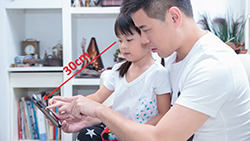

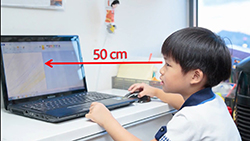
Don'ts:
- Look directly at glares or read under strong light.
- Stay under strong sunlight for a prolonged period without wearing sunglasses.
- Read on a moving car or in bed.
- Watch TV in a dim environment.
- Rub your eyes with hands.
- Place sharp objects and detergents or corrosives within children's reach or without supervision.
- Apply eye drops without consulting medical and health professionals.
The Maternal and Child Health Centres of the Department of Health provides vision screening for preschool children at 4 years old or above by registered optometrists / orthoptists. The 4- to 5 year-olds can be more co-operative, and so the examination result is more reliable. Since the vision of children at this age is still developing, early detection and treatment of amblyopia and associated visual problems can protect their vision development.

